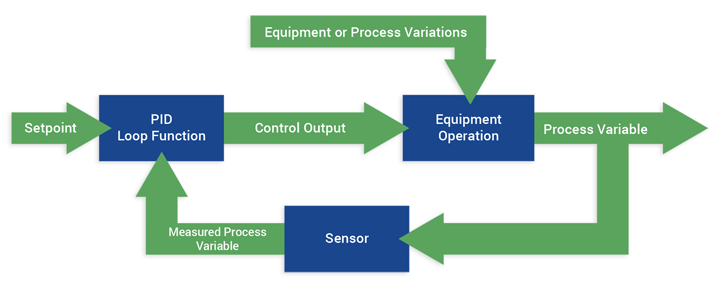
In HVAC systems, various motors and devices need to be controlled with modulated signals to turn damper actuators and hydronic reheat valves. Most controllers in the industry do this using specific and standard logic, called a Proportional Integral Derivative (PID) controller, or PID Loop. PID is mathematical logic that provides these three functions as parameters that can be tuned, so devices function accurately and optimally.
PID Loop Basics
A setpoint is the desired state of something (temperature, pressure, humidity, etc.). This is usually a stable function, such as 70°F for room temperature, 0.03” W.C. of room positive pressure, or relative humidity between 40%rh and 60%rh.
PID math is then applied in order to compensate for equipment or process variations such as changes in weather or if a door is left open. A change is sensed, adaptations are made, and then the process is looped back and repeated. PI loops (without the Derivative component) are more common.
Breaking It Down
- The PROPORTIONAL (or Gain) component depends only on the difference between the setpoint and the measured process variable. High gain tends to generate particularly aggressive corrective actions.
- INTEGRAL is the sum of all measured process variables since the process was started. This term is designed to drive steady-state in the setpoint.
- And DERIVATIVE is the rate of change.
A formula uses all three terms to control equipment to the desired results. Tuning a PID Loop sets optimal parameters in each variable to get an ideal response from a control system. There are different methods of tuning, but a common one is “guess and check.” That is, set variables by experience with that equipment and then check the results. Is the equipment performing as desired? If not, tune some more.
Accurate and reliable sensors are an important part of PI Loop operation. Capacitive sensors in particular are extremely accurate, able to detect changes in pressure as low as 0.0001” W.C. and are commonly found in most commercial-grade HVAC sensors as part of a larger Building Automation System (BAS) -- integral to the operation of any smart building and especially those housing critical environments like healthcare facilities.
CLICK HERE to learn more about how room pressure monitors are used in hospitals to keep patients safe.



